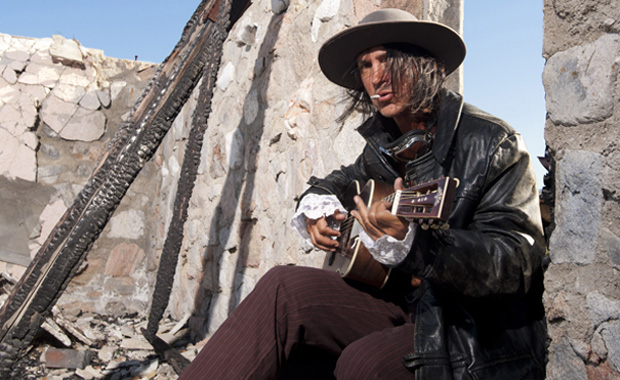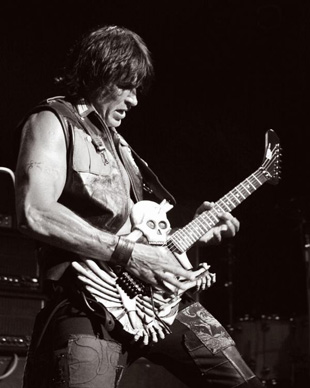Interview: George Lynch Discusses His New Solo Album, 'Kill All Control'

George Lynch, the man who wielded the axe for Dokken and now fronts his own bands Lynch Mob and Souls of We, likes to tinker.
At age 10, he remodeled his first electric guitar with a hack saw and “swapped the terrible pickups with new crappy pickups.” When he wanted a wall of amplifiers, he took the speakers out of his old amps and built new cabinets and put the speakers in those.
“I kept the old cabinets and stacked them on top of each other to make it look like I had a bunch of amps,” he said. “I would make these cabinets 6 feet tall, so they would look impressive, but they would only have one speaker in them. I made them out of Masonite and fiberglass and covered them with green shag carpet. Since I didn't know what I was doing, the new cabinets sounded horrible.”
A few years ago, he started his own guitar manufacturing company, Mr. Scary Guitars (www.mrscaryguitars.com), named after an instrumental jam on Dokken's 1987 album Back for the Attack.
In fact, when Guitar World called Lynch to talk about his new solo album, Kill All Control, which will be released July 19, he was at a computer salvage yard in Los Angeles.
“They have everything from amplifier tubes to torpedoes,” he said. “If there was an earthquake, you'd be buried under all the crap because they have stacks of junk that are 30 feet in the air.”

What do you do at salvage yards?
Get The Pick Newsletter
All the latest guitar news, interviews, lessons, reviews, deals and more, direct to your inbox!
I come here to scavenge for parts for guitar and amplifiers and what not.
How did your interests in tinkering and guitars come together?
My dad was an audiophile appreciator, and he had a lot of old stereo equipment when stereo first happene. We had all this reel-to-reel and headphone equipment and he'd make us sit there and listen to all this music. A lot of it was classical and flamenco guitars, jazz guitar, which got me interested initially. Also, being there when Beatlemania occurred didn't hurt either. My name was George and the guitar player in the Beatles was named George, so I put two and two together.
A few years after I started playing guitar, the Four Horsemen — Hendrix, Page, Clapton and Beck — came along. I learned to play their records by plugging my guitar into an old console stereo. I would plug my guitar into the headphone input, which distorted the signal and forced it out of the speaker. That eventually killed the circuitry, but that was my first amplifier.
When did you start building guitars for people other than yourself?
I used to assemble guitars for a lot of my students to supplement my income while I was teaching in various places. One of the people I worked for was Delores Rhodes, Randy Rhodes' mother, for a while. Randy got the Ozzy gig, but I got his teaching job. I would get $5 to $10 an hour, but I had kids to support, so I would build guitars for my students to supplement my teaching income.
In fact, Brent Woods, who plays with Jason Bonham's band, was a student of mine. I met up with him recently and he still has the guitar I built for him for $350.
The big news for you is the release of your new solo album, Kill All Control, on July 19.
The album is actually released as Souls of We in Japan, but as George Lynch everywhere else in the world. It started as a follow-up to the follow-up to the last Souls of We album, Let the Truth Be Known. The lineup started off with London LeGrand (Brides of Destruction), myself, Adrian Ost (drummer for Powerman 5,000) and Nic Speck (from Run Run Run) on bass. We went in as a band and our intention was to write and record a record in a month. We went in and wrote furiously and wrote the record in 10 days.The album features different lead singers. What happened?We went into the studio to record, and I ran into that “singer” wall. London is my friend and I love him, but a voice is not like a guitar. It's not a mechanical instrument, and singers are a different animal. Things just didn't work out and I had to look elsewhere for someone to complete the record, which took almost two years to finish. Had I known that retrospectively, I would have taken more time writing the music. [Laughs].Did the different lead singers dictate how the music was presented?I have an idea in my head of what melodies I would put in there if I could sing. I've hardly ever written with a singer and let them guide the ship. It's always been getting the song's instrumentals done first and then adding the vocals. We brought in Will Marten from Earshot and Keith St. John, who works with Montrose, and Mark Torien from the Bullet Boys.When were London's vocals recorded?London came back at the very end. I told him that he needed to be on the album, and we did a song that we worked on initially in his apartment. It's the lead track called “Wicked Witch,” and he did a beautiful job. Honestly, and I hate to say it, it made me cry. He'd been through a lot and it came out in his vocals. I think the best songs are the ones written from a personal place and a personal experience. Maybe it had that effect on me because I know him so well and I love him as a brother. He's a dear friend, and it's a beautiful song. I'm very proud to work with him on it.George Lynch's new solo album, Kill All Control, will be released July 19 on Rocket Science Records. For more info, visit georgelynch.com.
“There’d been three-minute solos, which were just ridiculous – and knackering to play live!” Stoner-doom merchants Sergeant Thunderhoof may have toned down the self-indulgence, but their 10-minute epics still get medieval on your eardrums
“There’s a slight latency in there. You can’t be super-accurate”: Yngwie Malmsteen names the guitar picks that don’t work for shred
![A black-and-white action shot of Sergeant Thunderhoof perform live: [from left] Mark Sayer, Dan Flitcroft, Jim Camp and Josh Gallop](https://cdn.mos.cms.futurecdn.net/am3UhJbsxAE239XRRZ8zC8.jpg)








